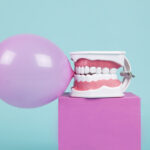How Long After A Dental Filling Can I Eat
Getting a dental filling is a common procedure used to restore a tooth damaged by decay or minor fractures. While it is a routine treatment, many people wonder how long they should wait before eating after getting a filling. The answer depends on the type of filling, the dentist’s recommendations, and your own sensitivity.
This guide will explore how soon you can eat after a dental filling, what foods to avoid, and tips for a smooth recovery.
Understanding Dental Fillings and Their Impact on Eating
A dental filling is used to restore the structure and function of a damaged tooth. The material used in the filling determines how soon you can eat. The most common types of fillings include:
✔ Composite (White) Fillings – These are tooth-colored fillings that harden quickly under a special curing light. You may be able to eat shortly after the procedure.
✔ Amalgam (Silver) Fillings – These take longer to harden, so waiting a few hours before eating is usually recommended.
✔ Gold or Ceramic Fillings – These are durable but may require extra care in the first few hours after placement.
Regardless of the filling type, following post-filling care instructions is essential to prevent discomfort and prolong the life of your dental work.
How Soon Can You Eat After a Dental Filling?
The waiting period before eating depends on the filling material and how your mouth feels after the procedure. Here’s a general guide:
1. Composite Fillings (White Fillings)
- These harden instantly with a special light, allowing most people to eat immediately after the procedure.
- However, if you experience numbness from anesthesia, it is best to wait until the numbness wears off to avoid biting your tongue or cheek accidentally.
2. Amalgam Fillings (Silver Fillings)
- These take a few hours to fully harden, so avoiding chewing on the filled tooth during that time is advised.
- Eating softer foods initially can help prevent damage to the new filling.
3. Gold or Ceramic Fillings
- These are durable but require careful chewing for the first few hours to allow the dental cement to set properly.
- Avoid putting too much pressure on the restored tooth immediately after the procedure.
Best Foods to Eat After a Dental Filling
Choosing the right foods after a filling can prevent discomfort and protect the newly treated tooth. Here are some recommended options:
✔ Soft Foods – Mashed potatoes, yogurt, scrambled eggs, and soups are gentle on the teeth.
✔ Lukewarm Foods – Avoid extreme temperatures; room-temperature foods are best.
✔ Nutrient-Rich Options – Soft fruits like bananas and avocados help promote healing.
✔ Hydrating Liquids – Water and herbal teas keep the mouth hydrated and reduce irritation.
Eating soft, non-sticky foods minimizes the risk of damaging the filling or causing sensitivity.
Foods to Avoid After a Dental Filling
Certain foods can cause discomfort or damage a new filling. Avoid the following:
❌ Hard Foods – Nuts, hard candies, and crunchy chips can put stress on the filling.
❌ Sticky Foods – Caramel, gum, and sticky candies can pull at the filling.
❌ Chewy Foods – Tough meats or chewy bread can put pressure on the treated tooth.
❌ Hot or Cold Foods – Ice cream, hot coffee, and soup can cause sensitivity in the newly filled tooth.
❌ Sugary Foods – Excess sugar can promote bacterial growth around the filling.
Avoiding these foods for at least the first 24 hours can help ensure your filling remains intact and pain-free.
Tips for Eating Comfortably After a Dental Filling
To make the post-filling recovery easier, follow these simple tips:
✔ Wait for Numbness to Wear Off – If you received local anesthesia, wait until the numbness subsides to avoid biting your tongue or cheek.
✔ Chew on the Opposite Side – If possible, chew on the side of the mouth that did not receive the filling to reduce pressure on the treated tooth.
✔ Take Small Bites – Cutting food into smaller pieces makes chewing easier and prevents discomfort.
✔ Use a Soft Toothbrush – Be gentle when brushing around the filled tooth to prevent irritation.
✔ Drink Plenty of Water – Water helps rinse away food particles and keeps your mouth hydrated.
Signs of Complications After a Dental Filling
While most fillings heal without problems, some issues may arise. Contact a dentist if you experience:
🔴 Persistent Pain – Mild sensitivity is normal, but ongoing pain could indicate a problem.
🔴 Filling Feels Too High – If your bite feels uneven, the filling may need an adjustment.
🔴 Cracked or Loose Filling – If you feel a sharp edge or notice the filling shifting, seek dental help.
🔴 Gum Irritation – Swelling or redness near the filling may indicate an allergic reaction or infection.
If any of these symptoms persist, seek professional advice as soon as possible.
Westwood Gardens Dental Clinic: One of the best dental clinics in Richmond Hill, Ontario
For those in Richmond Hill, Ontario, Westwood Gardens Dental Clinic is a trusted provider of high-quality dental care, including partial dentures. Call them today at 647-905-7303 or email info@westwoodgardens-dental.ca to schedule a consultation. You can also visit their clinic at Unit 18, 8868 Yonge St, Richmond Hill, ON, L4C 1Z8 for a comprehensive assessment and personalized treatment plan.
FAQs About Eating After a Dental Filling
1. Can I drink water immediately after a dental filling?
Yes, you can drink water right after the procedure. However, avoid extremely hot or cold drinks if you experience sensitivity.
2. Can I eat crunchy foods after a filling?
It’s best to avoid crunchy foods for the first 24 hours, especially if you have an amalgam (silver) filling that needs time to harden.
3. Why does my tooth feel sensitive after a filling?
Mild sensitivity is normal after a filling. The tooth’s nerves may take a few days to adjust to the new material. If sensitivity persists for more than a week, consult a dentist.
4. How long should I wait to eat if my mouth is numb?
Wait until the numbness wears off completely before eating to avoid biting your tongue or cheek accidentally. This usually takes a couple of hours.
5. Can I chew gum after getting a dental filling?
Avoid chewing gum for at least 24 hours after the procedure, especially if you have an amalgam filling, as it may disrupt the setting process.
Conclusion
Eating after a dental filling depends on the type of filling and your comfort level. While composite (white) fillings allow for quicker eating, amalgam and ceramic fillings require more time to harden before chewing. Choosing soft, lukewarm foods and avoiding sticky or crunchy items can help prevent discomfort and protect your new filling.
Following proper post-filling care, such as waiting for numbness to wear off, chewing on the opposite side, and maintaining good oral hygiene, ensures a smooth recovery. If pain or discomfort persists, consult a dentist for adjustments.
By being mindful of what you eat and how you care for your filled tooth, you can maintain strong, healthy teeth for years to come!




